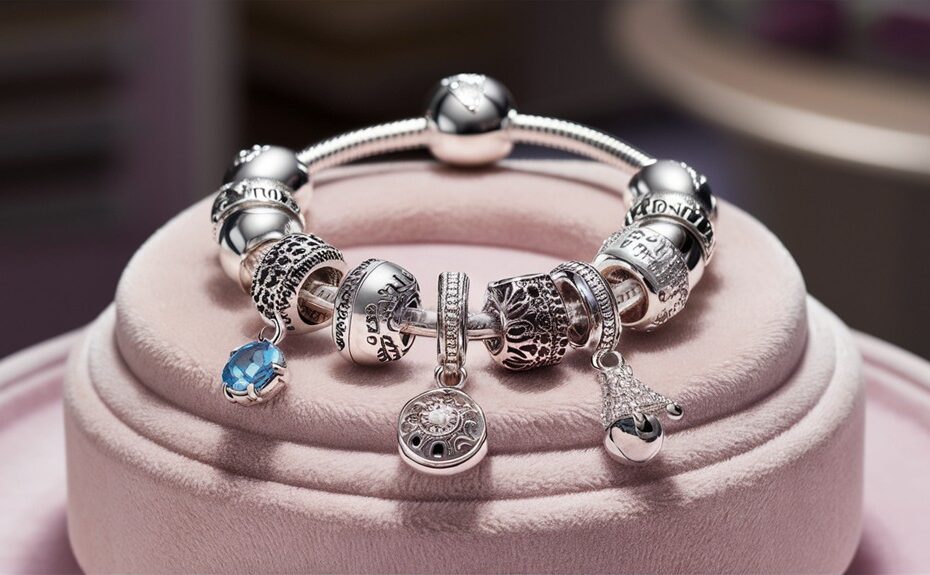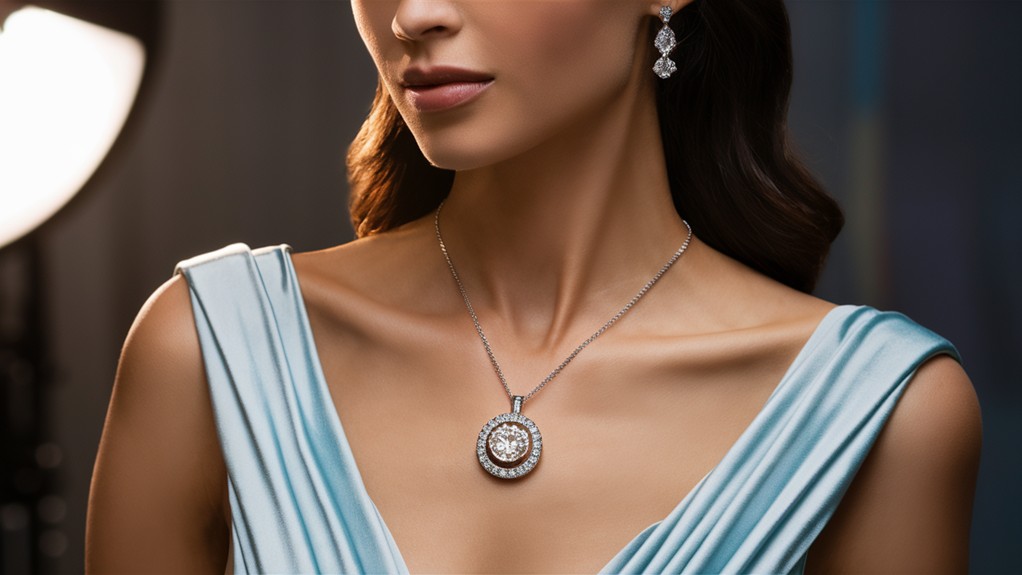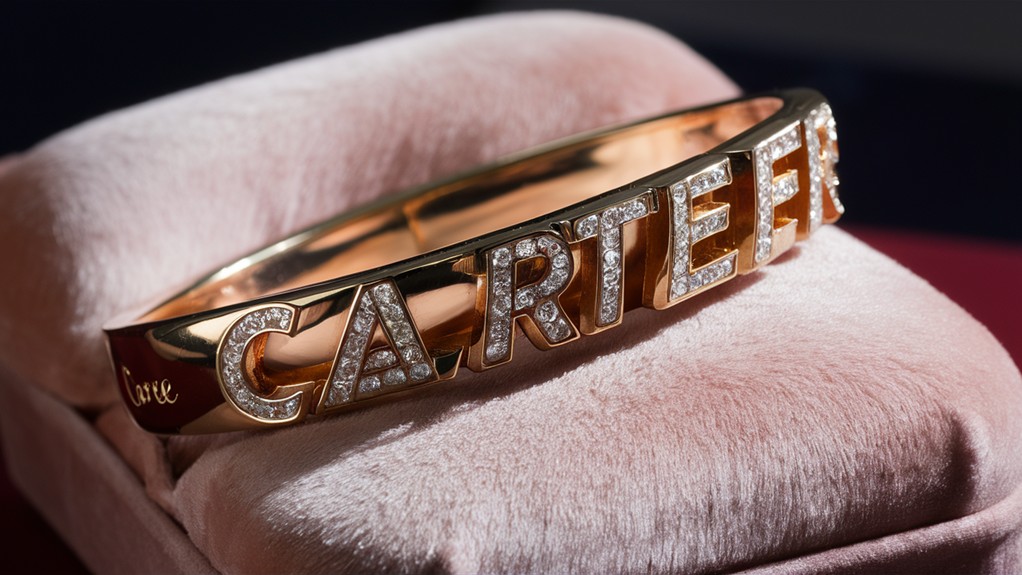As you investigate Pandora's transformation from a fashion accessory brand to a luxury jewelry powerhouse, you'll reveal the strategic steps that have propelled this evolution. You're about to uncover how clever marketing, innovative product design, and celebrity partnerships have reshaped Pandora's image in the competitive jewelry market. But there's more to this story than meets the eye. What hidden factors have contributed to Pandora's resilience in the face of economic challenges? And how has the brand managed to maintain its appeal while embracing sustainability? The answers might surprise you and change your perspective on the luxury jewelry industry.
Our Highlighted Points
- Pandora's strategic shift towards modernity and inclusivity expanded its appeal beyond traditional charm bracelets.
- Collaborations with celebrities and fashion events elevated Pandora's status in the luxury jewelry market.
- Product innovation combines reimagined classic designs with new materials and sustainability initiatives.
- Consumer insights drive product development, marketing strategies, and the brand's transition to a comprehensive jewelry line.
- Pandora balances its heritage of personalization and affordability with future ambitions in new product categories.
Pandora's Brand Evolution Journey
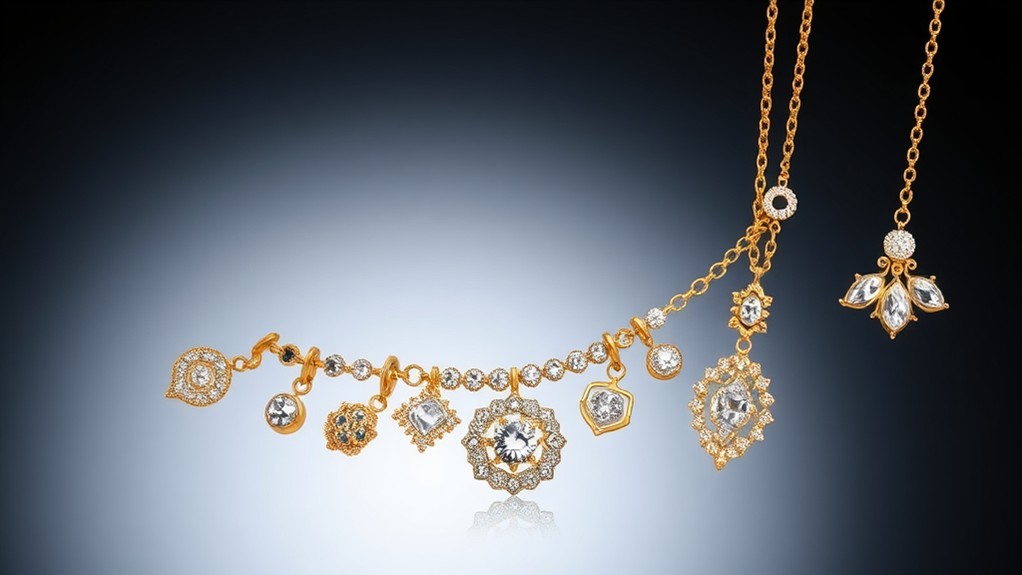
Pandora's brand evolution path has been marked by a strategic shift towards modernity and inclusivity. This transformation, while respecting the brand's heritage, has been driven by several key initiatives:
- Collaborations and partnerships:
- Fashion icon Pamela Anderson
- Copenhagen Fashion Week
- Strategic leadership:
- Appointment of Mary Carmen Gasco-Buisson as Chief Marketing Director in 2022
- Focus on maintaining brand relevance and competitiveness
- Marketing campaigns:
- Launch of the BE LOVE campaign
- Appeal to a broader consumer demographic
- Strategic events and marketing initiatives
- Sustainability commitment:
- 100% recycled silver and gold in jewelry production
- Goal achieved one year ahead of schedule
- Aim to halve greenhouse gas emissions by 2030 (based on 2019 levels)
- Future ambitions:
- Expansion from charm-centric offerings to all-encompassing jewelry brand
- Emphasis on community engagement
- Inclusivity in design process
You'll notice that Pandora's evolution includes not only aesthetic changes but additionally a commitment to sustainability and inclusivity.
This multifaceted approach demonstrates the brand's dedication to adapting to changing consumer preferences while maintaining its core values.
Marketing Strategies for Luxury Appeal
A masterclass in luxury marketing, Pandora's strategies for upscale appeal blend tradition with innovation. The brand's marketing strategy encompasses several key elements:
- Celebrity collaborations: Partnering with icons like Pamela Anderson boosts Pandora's status and broadens its appeal to the luxury market.
- Fashion event sponsorship: Aligning with high-profile events reinforces Pandora's position in the luxury jewelry segment.
- Emotional storytelling: The BE LOVE campaign and redesigned charms emphasize personal expression and emotional connections, resonating with upscale consumers.
- Direct-to-consumer model: This approach has driven revenue growth to $4.2 billion, showcasing Pandora's resilience in the luxury sector.
- Strategic leadership: The appointment of Mary Carmen Gasco-Buisson as Chief Marketing Director aligns marketing initiatives with product innovation, enhancing brand competitiveness.
- Sustainability focus: Incorporating eco-friendly practices into marketing strategies appeals to environmentally conscious luxury consumers.
Product Innovation and Celebrity Endorsements
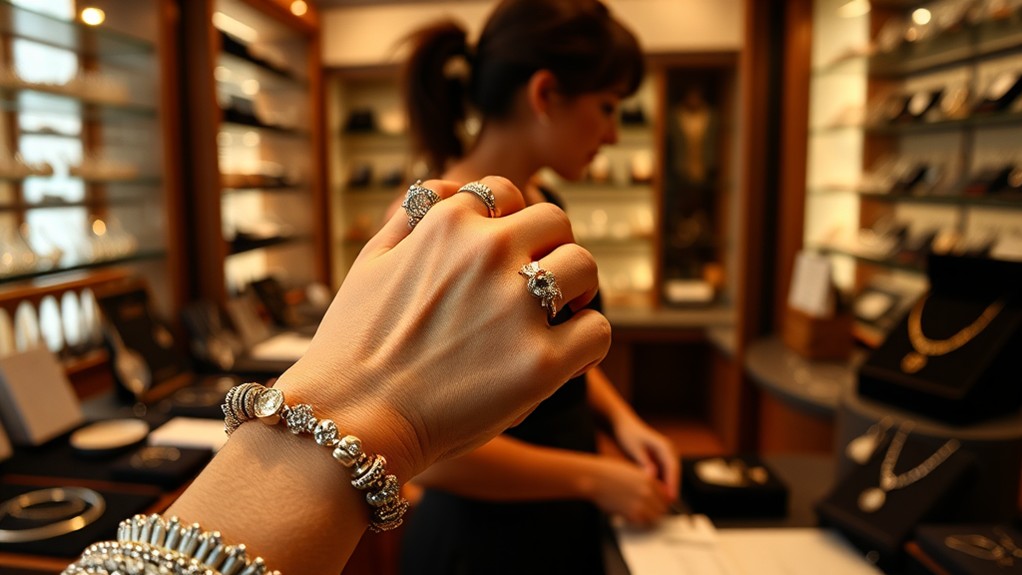
Building on its luxury marketing strategies, Pandora's product innovation and celebrity endorsements form the backbone of its continued success. The brand's commitment to innovation is evident in its reimagining of classic designs, such as the BE LOVE Heart charm from its 2000 collection. This three-dimensional charm, set to launch on August 25, 2024, exemplifies Pandora's approach to product innovation by merging nostalgia with modern appeal.
Pandora's use of celebrity endorsements further improves its brand relevance and consumer interest. By collaborating with high-profile celebrities like Pamela Anderson, the brand:
- Creates a buzz around new product lines
- Increases visibility in the luxury jewelry market
- Attracts a varied customer base
The introduction of new charms in different materials, including sterling silver and 14K yellow gold plating, demonstrates Pandora's commitment to product innovation while maintaining aesthetic appeal.
Moreover, strategic partnerships with fashion designers like ROTATE allow Pandora to showcase its jewelry on prominent runways, solidifying its status in the luxury market. These collaborations not only increase brand exposure but also reinforce Pandora's position as a trendsetter in the jewelry industry. With ROTATE being a coveted brand in the fashion industry, collaborating with them elevates Pandora’s luxury designer brand profile 2024. This partnership helps Pandora align itself with the latest fashion trends and positions the brand as a leader in the high-end jewelry market. By leveraging these strategic partnerships, Pandora can continue to attract fashion-forward consumers and maintain its position as a top player in the luxury jewelry segment.
Economic Performance and Market Resilience
Economic resilience shines through Pandora's impressive financial performance in recent years. The brand's ability to navigate challenging market conditions is evident in its revenue growth from $3.96 billion in 2022 to $4.2 billion in 2023. This upward trajectory underscores Pandora's strong market resilience and strategic positioning within the jewelry industry.
Key factors contributing to Pandora's economic performance include:
- Minimal price increases in spite of rising raw material costs
- Direct-to-consumer sales model maintaining healthy profit margins
- Large-scale production practices ensuring quality and cost efficiency
You'll notice that Pandora's commitment to affordable luxury remains unwavering, even in the face of economic fluctuations. The brand's strategic focus on geographical expansion and improved customer experience further solidifies its market position.
To fully appreciate Pandora's economic resilience, consider the following:
- Consistent revenue growth year-over-year
- Ability to maintain competitive pricing without sacrificing quality
- Successful adaptation to changing consumer demands and market trends
Sustainability Initiatives in Jewelry Making
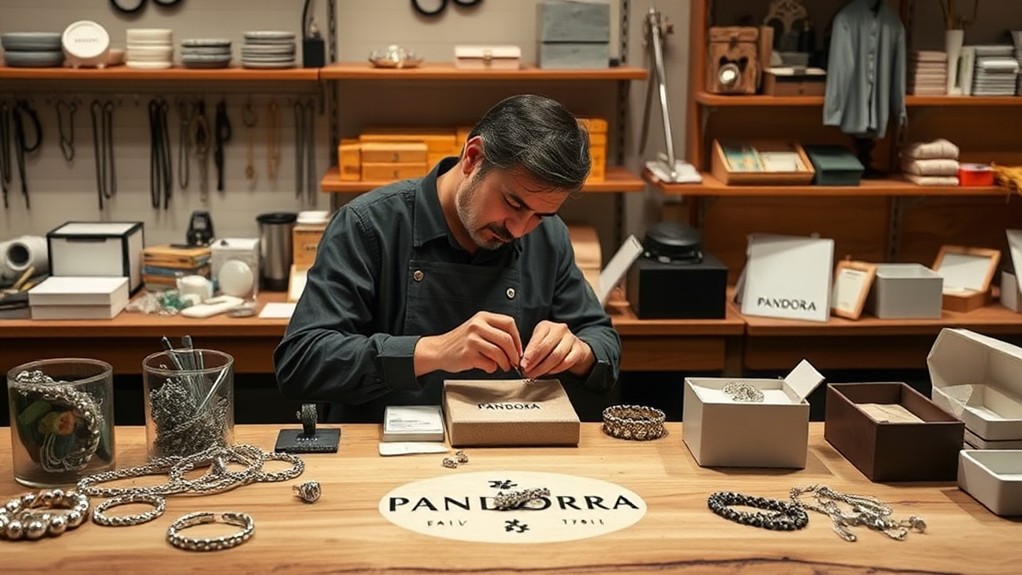
Sustainability stands at the forefront of Pandora's jewelry-making practices. The brand's commitment to using 100% recycled silver and gold in its crafting process, achieved a year ahead of schedule, exemplifies its dedication to eco-friendly production.
Pandora's sustainability initiatives extend beyond material sourcing, encompassing ambitious goals to reduce greenhouse gas emissions by 50% by 2030, based on 2019 levels.
In developing new products, Pandora integrates sustainability considerations throughout the design process. This approach aims to appeal to environmentally conscious consumers in emerging markets, where eco-friendly practices are increasingly valued.
By maintaining direct links with customers, Pandora gains valuable insights into sustainability preferences, informing both product design and marketing strategies.
The brand's sustainability efforts are woven into its core ethos, ensuring that environmental responsibility coexists with aesthetic appeal. This integration is evident in:
- The use of recycled precious metals in crafting
- Emission reduction targets aligned with global climate goals
- Product development focused on sustainable materials and processes
Creative Process Behind Pandora Designs
Pandora's creative process blends artistry with consumer insight to craft jewelry that resonates with its global audience. The brand's creative directors utilize customer feedback and market trends to develop prototypes that align with consumer preferences. This approach aligns with Pandora's "Phoenix strategy," emphasizing sustainable and profitable revenue growth through design innovation.
The meticulous craftsmanship behind each piece is evident in the fact that, on average, Pandora jewelry passes through 25 pairs of hands during production. This attention to detail guarantees that every item meets the brand's high-quality standards while reflecting individual expression and contemporary aesthetics.
Key elements of Pandora's creative process:
- Customer-centric design: Incorporating feedback to guide innovation
- Trend analysis: Transforming market insights into tangible designs
- Prototype development: Creating physical representations of concepts
- Sustainability focus: Utilizing 100% recycled silver and gold
- Quality control: Rigorous craftsmanship involving multiple artisans
Consumer Insights Driving Brand Direction

Insight forms the backbone of Pandora's brand strategy, driving product development and market positioning. Consumer insights play a pivotal role in shaping the brand's direction, allowing Pandora to capture diverse feelings and attitudes across demographics.
By leveraging feedback loops and data-driven approaches, the company can identify interesting differences in consumer preferences, tailoring offerings to meet specific cultural and regional demands.
This consumer-centric approach has guided Pandora's transition from charm-centric products to a thorough jewelry line. The brand's focus on personalization and unique, meaningful pieces stems directly from consumer insights, ensuring that new products connect with local market needs.
Furthermore, understanding sustainability preferences has led to initiatives like the use of 100% recycled silver, aligning with the growing demand for responsible practices in the jewelry market.
To visualize Pandora's consumer-driven strategy, consider the following:
- Feedback loops informing design and innovation processes
- Data analytics identifying regional and cultural preferences
- Sustainability initiatives guided by consumer values
Balancing Heritage With Future Ambitions
As a legacy brand with a strong charm-centric identity, Pandora faces the challenge of evolving while honoring its roots. The company's transition to a thorough jewelry brand requires a delicate balance between preserving its heritage and embracing future ambitions. This evolution involves:
- Expanding product categories, including lab-grown diamonds
- Maintaining personalization and affordability as core values
- Leveraging consumer insights for design innovation
To achieve this balance, you'll notice Pandora:
- Unlearning established perceptions while retaining brand essence
- Focusing on affordable luxury to broaden appeal
- Adapting designs to local market preferences
- Building a recognizable identity across diverse product lines
The brand's creative process integrates consumer feedback, ensuring new offerings connect with target markets. This approach allows Pandora to:
- Innovate while staying true to its heritage
- Expand its cultural impact through community engagement
- Create a unified brand narrative that spans past and future
Community Engagement and Brand Loyalty
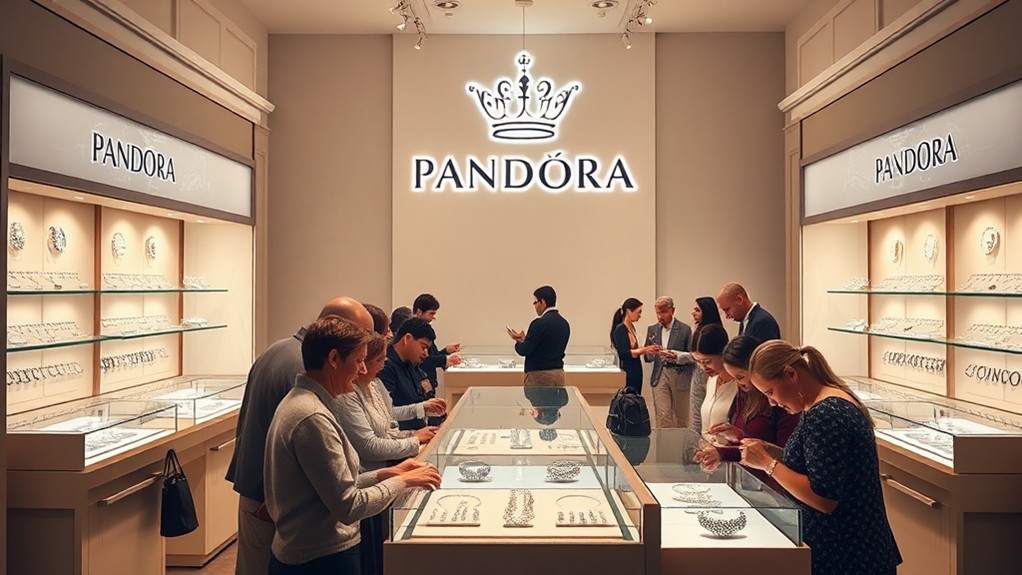
Building a devoted following requires more than just selling jewelry; it demands a deep connection with customers. Pandora has welcomed community engagement as a cornerstone of its brand strategy, recognizing that fostering a sense of belonging is vital for long-term success. By involving consumers in the creative experience, Pandora creates an emotional bond that rises above mere transactions.
The BE LOVE campaign exemplifies Pandora's commitment to inclusivity and brand loyalty. This initiative aims to:
- Uplift the brand's image
- Connect with diverse consumer demographics
- Promote a message of universal love and acceptance
Collaborative events and partnerships play a significant role in Pandora's community engagement efforts. By aligning with influencers and brands like ROTATE and Pamela Anderson, Pandora boosts its visibility and strengthens emotional connections with its audience.
These collaborations serve as touchpoints for consumers to interact with the brand beyond traditional retail experiences.
Fundamental to Pandora's success is its feedback loop system. By actively soliciting and incorporating customer input into design and innovation processes, Pandora guarantees that new products resonate with consumer preferences.
This approach not only improves brand loyalty but also demonstrates a commitment to evolving alongside customer needs and desires.
Frequently Asked Questions
Is Pandora Jewelry Considered Luxury?
Yes, Pandora's considered a luxury brand. You'll find it's positioned as affordable luxury, offering quality craftsmanship and materials. It's gained prestige through celebrity endorsements, innovative designs, and sustainable practices, all while maintaining accessible pricing.
What Makes Pandora Jewelry so Special?
You'll find Pandora jewelry special for its customizable charm bracelets, allowing you to tell your unique story. They're crafted with care, using high-quality materials like recycled metals. You're getting affordable luxury with trendy designs and emotional resonance.
What Is Pandora's Marketing Strategy?
Pandora's marketing strategy focuses on modern inclusivity. You'll see them collaborating with celebrities, sponsoring fashion events, and launching campaigns like BE LOVE. They're emphasizing individuality, using direct-to-consumer sales, and balancing affordability with luxury appeal to stay competitive.
What Is the Message of Pandora Brand?
Pandora's message is all about you. They're saying you're unique, and your jewelry should tell your story. You can express yourself, celebrate love, and welcome sustainability through their customizable, eco-friendly pieces. It's your personal expedition, stylishly crafted.
